The History Of SAAB 9 3

The Saab 9-3 is a compact executive car produced by the automaker Saab in Trollhättan, Sweden. The convertible (cabriolet) version is manufactured in Austria by Magna Steyr. The 9-3 shares platform with the Opel Vectra, and with the Cadillac BLS made on the same assembly line in Sweden. It is Saab's entry-level model, except in 2005-2006, when the Subaru Impreza-based Saab 9-2X was its entry-level model.
The car is badged as 93. Saab however consistently advertises it as 9-3. The name is pronounced "nine three". The 9-3 was introduced in 1998 and succeeded by a redesigned 9-3 in model year 2003. The Saab 93, pronounced "ninety three" was a car produced by Saab from 1955 to 1960.
The first generation 9-3, a substantially improved last-generation Saab 900 was launched in 1998 for the 1999 model year. It featured slightly sleeker styling with some models sporting a black rear spoiler and removed Saab's trademark centrally-mounted "snow flap". It was available as a three or five-door hatchback, and as a two-door convertible. It was the last small Saab to use the company's H engine. Notable improvements over the Saab 900 were improved ride and handling and substantially improved crashworthiness with standard side impact airbags with head protection and active headrests. The Saab 9-3 along with the Saab 9-5 and the Volvo S70 were the first cars in the world to earn the maximum score in a side impact augmented by a pole test[citation needed] based on Euro NCAP testing.
It was also available with a new variant of the B204 engine (B204E), a low pressure turbo (LPT) engine based on the B204L used in the last generation Saab 900. The first generation 9-3 was also the first Saab available with a diesel engine, an Opel sourced engine shared with the Opel Vectra
A Saab innovation is the 'Night Panel', carried over from the Saab 900, which permits dousing of the instrument panel lighting, except for essential information, for less distraction when night driving.
A total of 326,370 first generation 9-3s were built.
Viggen
A high-powered version of the 9-3 was the Viggen (from the Swedish åskvigg, meaning "thunderbolt"), named after the Saab 37 Viggen aircraft. It is no longer in production. It came with a turbocharged 2.3L engine, giving 225PS (165kW) (later 230PS (170kW)). Acceleration from 0-100km/ h could be reached in 6.4 seconds and the top speed is 250km/ h (155 mph). To handle the high power and performance the following elements were changed/ modified: heavy duty clutch and pressure plate, stiffened and lowered springs, firmer dampers, stronger CV joints and driveshafts. In addition to extra power and torque, it also featured a special rear wing (increasing the downforce by 50%[citation needed]) requiring relocation of the radio antenna, aerodynamically designed bumpers and side skirts (reducing the drag coefficient by 8%[citation needed]), specially bolstered and colored leather seats (available in four colors: black with black inserts, black with blue (lightning blue) inserts, and black with orange (red ochre) inserts), sportier suspension, bigger wheels, upgraded brakes, and other upgraded parts. Production quantity and color choice was very limited (Fewer than 3000 Viggens manufactured; available colors are lightning blue, monte carlo yellow, steel gray, silver, black, or laser red). The Viggen was only available with a five speed manual transmission, CD player, and the Viggen specific motorized and heated leather seats. In 1999, the Viggen was the first 9-3 with the Saab's own Trionic 7 engine management system, which makes 2,000,000 calculations every second from combustions temp, boost control, variable torque curves and many other critical engine processes.
New Viggen buyers in the USA were treated to two days of advanced driving instruction at Road Atlanta and dined with Saab USA executives from nearby Norcross, Georgia. This program, operated by Saab and Panoz, was called Viggen Flight Academy and later transformed into the current SAAB Aero Academy.
The Viggen was created for performance seeking Saab enthusiasts and remains very desirable among Saab enthusiasts. Some motoring journalists were critical of untamed torque steer in low gears.
500 units were produced for the UK market.
Engines
- 2.0L B204 I4, 130PS (96kW) ECE (1998-1999)
- 2.0L B204E (non-US) I4, turbo LPT, 154PS (113kW) (1998-2000)
- 2.0L B204 I4, turbo, 185PS (136kW) (1998-1999)
- 2.0L B205 I4, turbo, 185PS (136kW) (2000-2002)
- 2.0L B205E (non-US) I4, LPT(light pressure turbo), 150PS (110kW) (2000-2002)
- 2.0L B205R I4, turbo, 205PS (151kW) (1999-2003)
- 2.3L B235R I4, turbo, 230PS (170kW) (1999-2002)
- 2.2 TiD I4 D223L 2171 cc, 115PS (85kW)
- 2.2 TiD I4 2171 cc,125PS (92kW)
The second-generation model was launched at the North American International Auto Show in early 2002; the most drastic visual change was the elimination of the hatchback design. All U.S. market gas-powered variants featured a 2.0L straight-4 engine derived from General Motors' Ecotec family (originally designed by Saab engineers). There are three different versions of the turbocharged I4, with the amount of turbo boost determining the power output. The 150hp (110kW) version (though two litre, it is called 1.8t) was standard in the non-U.S. market Linear form (trim-level). The 175horsepower (130kW) version (2.0t) was standard in U.S. market Linear or non-U.S. market Vector form, mated with a 5-speed manual transmission or a 5-speed Sentronic automatic, which allowed for shifting without a clutch pedal. The 210 horsepower 2.0T was available in both the Arc and Vector forms, and the same Sentronic transmission was available, though in the Vector, paddle shifters mounted on the steering wheel were added. In 2003 Arcs and Vectors, the manual transmission was a 6-speed.
2004
Supposedly due to a request from Vector Aeromotive, the Vector form was replaced with the Aero in the United States. In addition, the Arc received the 5-speed manual in lieu of the 6-speed.
The 9-3, like all Saabs, is a front-wheel drive car. It is available as a four-door sedan, a wagon (introduced late in 2005, known as the SportCombi, SportWagon or Sport-Hatch depending on the markets), and a two-door convertible. It includes a number of safety features, including innovations such as Saab Active Head Restraints (SAHR II) to reduce whiplash and ReAxs, passive rear wheel steering to reduce understeering and passive toe-in under heavy braking. In certain markets, the local distributor sells versions unique to that market. For example, in Singapore, 2.0t are not imported. Rather the 1.8t (which is actually a 2.0 litre low pressure turbo with a 150hp (110kW) output) is sold with a Hirsch modification to increase the horsepower to around the output of a 2.0t. Furthermore, in Singapore 1.8t cars are available only with automatic transmission unless specially ordered.
The 9-3 and the Opel Vectra were the first of the global GM Epsilon platform, which was then lengthened to accommodate four new cousins, the Chevrolet Malibu/ Malibu Maxx, the Pontiac G6, and the Saturn Aura. Even so, this platform was heavily re-engineered by SAAB, making it 60% exclusive[citation needed] and rendering it impossible to build outside its Trollhättan plant[citation needed]. A proprietary fiber-optic electric/ electronic system, the possibility of AWD (exploited from 2008 on, dubbed Saab XWD), and ReAxs as described above, are just a few of the features exclusive to the 9-3.
2005
United States versions were sold with 16" wheels standard (17" for the Aero) unlike the 15" wheels which were previously found in the Linear version. In the United States, but not in most countries, the 2005 was the last year of the Linear and Arc versions.
2006
A special "20 Years Edition Aero Convertible" for the American market was unveiled at the Los Angeles Auto Show in January 2006 to celebrate 20 years since the introduction of the Saab 900 convertible. For 2006, the two optional engines were a 2.0 liter turbo 4 cylinder and a new 2.8 liter turbo 6 cylinder. The 4 cylinder option had 12.3 psi maximum turbo boost pressure and turned out 210hp (160kW), while the 6 cylinder had 8.7 psi boost and turned out 250hp (190kW). The 2.0 liter 16 valve turbo 4 cylinder model was marketed in the United States as the 2.0T, replacing the Linear and Arc models sold until the 2005 model year. The United States 2.0T version was similar to the 2005 Arc except for U.S. Linear wheels were used. The Linear and Arc versions continued to be sold in most other countries. In the middle of the 2006 model year, at least for cars made for the United States market, the trunk release button on the driver's door was eliminated, possibly to save costs. Cars made in the first half of 2006 have the trunk release mechanism mounted on the driver's door. After it was eliminated, the only way to open the trunk is to use the key fob (and the emergency release located inside the trunk for use by people who climb into the trunk ).
2007
The dashboard was completely revamped for 2007, with the Saab Information Display moved from its high mounted position to the main instrument binnacle, and a return to the look of the classic Saab 900 dash. The button-heavy climate control system disappeared, replaced by the Saab 9-5 climate control system, OnStar was re-introduced and required when Nav was ordered, and the corporate GM head unit debuted, which allowed for satellite radio and MP3 CD capability. While the 2008 model is touted as all-new, the majority of under skin enhancements occurred for the 2007 model year. The suspension went from borderline harsh to firm, and the cabin was quieted considerably. Steel Gray was also replaced with Titan Gray as an exterior color choice. In the U.S. market, only the 210 hp 2.0 litre 16 valve turbo engine and the 250 hp 2.8 litre V-6 turbo were available. The manual transmission in the 2.0 model was changed from a 5-speed to a 6-speed.
2008
The 2008 range, presented at the Saab Festival in Trollhättan, Sweden (June 10, 2007) included new frontal styling inspired by the Saab Aero-X, new door panels, a clamshell hood, and frosted rear lamps. Slight exterior modifications are available on the limited-edition XWD 280bhp 9-3 Turbo X, presented at the Frankfurt Motor Show (9/ 07). The Turbo X made its North American debut at the New England Auto show in late November. Saab also released an all-wheel drive version of the Aero, with the system dubbed "XWD", in March 2008.
Engines
Note: diesel engines are not available in North America. Starting from 2005 diesel engines are Fiat sourced common rail units.
- 2003-2004 - 2.2L GM D223L diesel I4, 125PS (123hp/ 92kW)
- 2005-present - 1.9L TiD I4, 120PS (118hp/ 88kW)
- 2005-present - 1.9L TiD I4, 150PS (148hp/ 110kW)
- 2007-present - 1.9L TTiD I4, 180PS (178hp/ 132kW)
- 2004-present - 1.8L Ecotec I4, 122PS (120hp/ 90kW)
- 2003-present - 2.0L Ecotec I4, low-pressure turbo, 150PS (148hp/ 110kW)
- 2003-present - 2.0L Ecotec I4, low-pressure turbo, 175PS (173hp/ 129kW)
- 2003-present - 2.0L Ecotec I4, high-output turbo, 210PS (207hp/ 154kW)
- 2006-present - 2.8L HFV6 V6, low-pressure turbo,230PS (227hp/ 169kW)
- 2006-present - 2.8L HFV6 V6, turbo, 250PS (247hp/ 184kW)
- 2006-present - 1.8t BioPower 1998 cc I4, turbo 175PS (173hp/ 129kW). Flexfuel (E85) vehicle.
- 2006-present - 2.0t BioPower 1998 cc I4, turbo 200PS (197hp/ 147kW). Flexfuel (E85) vehicle.
Saab Turbo X
Saab Turbo X is a limited edition special version of the 9-3 revealed at the 2007 Frankfurt auto show. It is made to celebrate SAAB's 30 years of turbocharging. All Turbo X are offered in metallic jet black with matte grey trim. The Turbo X is SAAB's first production car with the XWD all-wheel drive system from Haldex Traction and eLSD. It is powered by a 2.8 litre V6 producing 280PS (210kW) mated to a six speed manual or automatic gearbox. It also has larger brakes as well as stiffer springs and shocks. The dash, shift lever and door panels have carbon fibre look and the turbo boost gauge draws its inspiration from the Saab 900.
2005, 2006, 2007, 2008 and 2009
- Top Safety Pick - Gold Award, Insurance Institute for Highway Safety, USA.
2004
- Best Pick in side-impact crash tests,Insurance Institute for Highway Safety. The Sport Sedan repeats the "Best Pick" rating from last year's IIHS frontal offset crash test and is now the first car with standard safety equipment to receive a double "Best Pick" honour.
- Received highest rating, "Good" in the IIHS & Thatcham studies into the safety of car seats and head restraints, Insurance Institute for Highway Safety USA, Thatcham, Great Britain.
- Awarded Compact Executive Car of the Year, Auto Trader, Great Britain
- Voted Top Small Executive Car, Top Gear Magazine's New Car Buyer's Guide, Great Britain
- Awarded one of "10 best Cars of the Year", Hong Kong Car and Driver, Hong Kong
- Awarded Best European Intermediate/ middle sedan, Car Plus Award, Hong Kong
- Recommended buy, US Consumer Reports magazine, USA
- Awarded maximum five star rating in EuroNCAP collision test, Saab 9-3 Convertible, EuroNCAP
- Named UK's Most Secure Open-Top Car, British Insurance Car Security Awards, Great Britain
- Prestigious Sporting Open Top award, The Institute of Vehicle Engineers (IVehE), Great Britain
2002
- Awarded maximum five star rating in EuroNCAP collision test, Saab 9-3 Sports Sedan, EuroNCAP
- Best Family Sedan, Saab 9-3 Sport Sedan, PBS's MotorWeek television, USA
- Prestige Car of the Year, Saab 9-3 Sport Sedan, Brisbane Courier Mail, Australia
- Best Buy, Saab 9-3 Sport Sedan, Expressen, Sweden
- Best New Car, Saab 9-3 Arc Sport Sedan ($30,000 - $40,000 range), Kiplinger's Personal Finance magazine, USA
1999
- Among the Top Ten Cars of 1999. Fortune Magazine, USA
1998
- One of the Top Ten Cars - Fortune Magazine, USA
- Among Top Ten Family Cars - Consumer's Review, USA
From Wikipedia, the free encyclopedia
More About SAAB 9 3
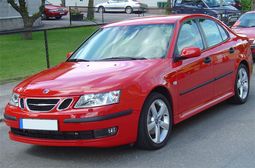
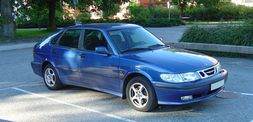
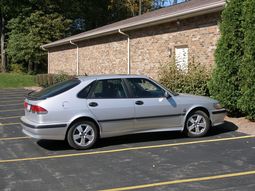
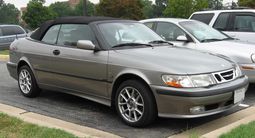
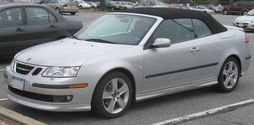
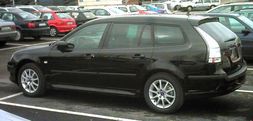
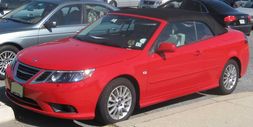
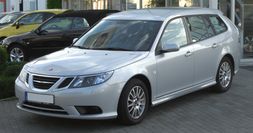
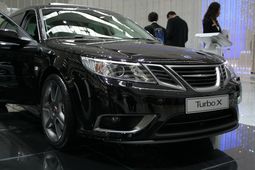
|